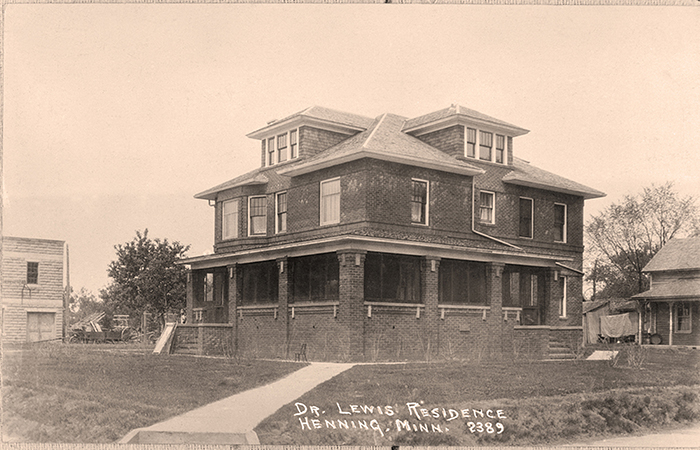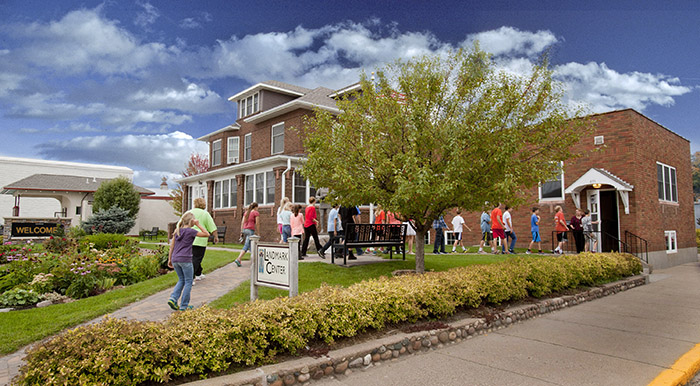A historic designation in Henning
News | Published on January 18, 2022 at 4:05pm EST | Author: Chad Koenen
0Landmark Center placed on National Register of Historic Places

The Dr. AJ Lewis residence and clinic was recently placed on the National Register of Historic Places. The building was revitalized about 15 years ago when it was transformed from a clinic to the Landmark Center.
By Chad Koenen
Publisher
The Landmark Center is joining some pretty historic company—literally that is. ¶ The Henning landmark, which was originally constructed as a clinic and doctor’s residence in 1914, was listed on the National Register of Historic Places at the end of December. The facility will join the Trinity Center, which was added to the same list in 2018. ¶ “I think it is rewarding. It is a feather in our cap and a feather in the cap of Henning to have two places on the National Register of Historic places. To have two buildings listed on Main Street in Henning (is a big accomplishment),” said Landmark Center Executive Director Dan Broten.
Of an almost equal importance to the Landmark Center is the added access the designation provides for grant opportunities. Being on the national register will allow the Landmark Center the ability to access grants for things like funding for future building projects, windows, and more.
“We rely on all of these extra grant support we get,” said Broten.
Those additional grants are in addition to the local donations the organization gets to put on countless community activities and art projects throughout the year. While many of the grants the Landmark Center gets support a specific class or activity, they oftentimes don’t offer funding to help pay the month-to-month bills like utilities and staffing to keep the facility going.
“It has brought a lot of money here for the research of these buildings,” said Broten of the Legacy fund. “It has also brought us art opportunities to the community.”

One part of the Legacy funding that Broten was especially grateful for was the ability to receive a grant to complete all of the necessary work to have the Trinity Center and now the Landmark Center placed on the National Register of Historic Places. That included a property evaluation grant to determine if the property was even eligible to be placed on the National Register of Historic Places, and also the nomination process to complete the historic registry work.
“Because of that fund we were able to get not one, but two properties listed on the National Register of Historic Places,” said Broten. “Landmark has also benefited from a lot of funding for the ongoing projects here and some operating money.”
While many of the grants the Landmark Center receives pay for a specific art project, like last summer’s mural painting at the bathrooms in the city park, the Legacy grants also provides the facility with anywhere from $6,000-8,000 to help pay for operating expenses. The Landmark Center also receives project specific grants and organizational legacy grants for things like the summer workshop series. Those grants are in addition to the local funding it receives from the City of Henning, Espeland Foundation and local donors.
An already expansive process, COVID-19 stretched out the Landmark Center nomination process to nearly two years.
The Trinity Center was placed on the National Register of Historic Places in 2018 due to its unique architecture and the twin spires atop the facility. Since that time, the facility has received a number of grants to help with the restoration of the church that dates back to the 1890s.
The Landmark Center was named to the historic list due to its importance as a healthcare facility in the early days of the community. Broten said a group of researchers discussed including the importance of the architecture of the building, but wanted to really focus on the fact the facility was used for healthcare and home for doctors throughout much of the 20th century.
“It’s really focusing on the years A.J. (Lewis) built the house and Charles (Lewis) was here,” he said. “They tagged on the Lewis home, because originally it was the Lewis house and medical clinic.”
The clinic and house opened in 1914 in the heart of Henning. During those early years, doctors routinely made house calls, while also seeing some patients at the clinic. Since the area wasn’t nearly as developed as it is today, doctors were of up-most importance to help keep people healthy within the immediate area of a community.
The original Landmark House was built in 1914, expanded in 1948, and served as residence and medical clinic for doctors A.J. Lewis, Charles Lewis, Jay Kevern, and Jon Wigert.
With such a prominent location in downtown Henning not being utilized, as well as a need for additional community meeting space, Broten said Cynthia Fossey and Clarice Espeland were among a group of people who spearheaded the idea of transforming the former clinic building into a community space. The building was owned by long-time doctor Jon and Annette Wigert, who sold the building with the intent that would be used as a community establishment.
“Had he not decided to let this place go it would have never turned into the place it is now,” said Broten of the Wigerts. “It could have been a storage building or another residence.”
Construction began in 2006 and took nearly 2 1/2 years to complete. Broten said after years of being used as a storage building, as opposed to a clinic, there was quite a bit of work that needed to be done in order to turn the once prominent centerpiece of Henning’s downtown into a community building once again.
The building opened in 2009 and Broten said the first director Sharon Thalmann was brought on board to make the vision of a community building come to life.
Broten said one of Espeland’s requests early on was to have a place where people could come in, read a book and use a computer when needed. In many ways, that vision is how the community library and sitting room came to life at the Landmark Center. Due in large part to the amount of grants and Legacy money available in the arts field, the Landmark Center also took on an arts and entertainment niche in the community.
Over the years the library and sitting room has remained, but the facility has also expanded into trying to fills needs in Henning. For example, the Landmark Center has become a popular place for bridal showers, graduation parties and a meeting space for local non-profits. It has also expanded into offering bedrooms to rent for guests in the community in a bed and breakfast type environment.
There is also an ever-growing museum in the basement that features everything from high school memorabilia to the chair once used during the World War II era to watch for enemy planes above the Henning Community Center. There have also been artist retreats and workshops held on the front lawn of the Landmark Center, which includes glassblowing demonstrations, art displays, blacksmith workshops and more.
The facility was also the benefit of a Blandin grant that Otter Tail County received to set up Smart rooms across the region. The Smart room provides an internet hot spot outside of the Landmark Center for individuals who need to access high speed internet.

